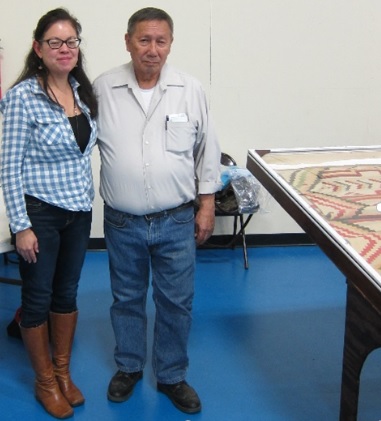The Long, Dark Journey of a Historic Textile Treasure

Depiction of the Sand Creek Massacre by Cheyenne eyewitness and artist Howling Wolf, ca. 1875. Image courtesy of the Allan Memorial Art Museum at Oberlin College.
From 1864 to 1929, one of the most storied Navajo chief’s blankets was missing.
This blanket, widely considered the finest example of Navajo weaving from the classic period (1850–1863), was taken over 150 years ago from a battlefield in southeastern Colorado Territory following the Sand Creek Massacre. The circumstances under which the blanket disappeared were all too common during the American Indian Wars, when the systematic removal of Native people by the US government resulted in the subsequent destruction and theft of Native artifacts.
The battle at Sand Creek was no different.
As dawn broke on November 29, 1864, the Third Colorado Cavalry Regiment, violating a peace agreement reached just a few months earlier, attacked and destroyed a sleeping village of Cheyenne and Arapaho people. The blanket was taken from the body of Chief White Antelope, a prominent Cheyenne peace chief, by US cavalryman Henry Mull.
Originally called hanoolchaadi in Navajo, by the mid-nineteenth century the blankets had become a valuable trade item among the Native and Spanish people throughout the West. Their quality was extraordinary: the fibers were so fine and tightly woven that the blankets became almost waterproof and could be used as coats by day and blankets by night, replacing heavy buffalo skins. But they were also valued for their beauty and worn as ceremonial shoulder wraps for special occasions by not only Navajo, but also Cheyenne, Kiowa, Sioux, and Ute tribal members.
The name “chief’s blanket” was coined by traders because the blankets were so expensive that only chiefs or other wealthy individuals could afford them. In 1860, according to Navajo weaving expert Tyrone Campbell, the blankets sold for $100 to $150 each. At the time, Campbell notes, “that was a year’s wages.”
Indeed, in March 1865 Henry Mull sold the White Antelope blanket for $150 to an unknown party. It soon came into the possession of George Clark (who may, in fact, have purchased it from Mull). Clark was a prominent banker in Denver who served as mayor from 1865 to 1866. The blanket was then inherited by Clark’s daughter, Fannie Clark Wiggington, who sold it in 1929 to the Indian Arts Fund (IAF) for $2,500.
The blanket’s battlefield provenance, based on testimony provided in a letter to George Clark by an officer of the Third Colorado Cavalry Regiment, was credible, but this may not have been the first time the textile was stolen. Contemporary Cheyenne elders and descendants of Chief White Antelope believe the chief may have confiscated the blanket from a wealthy Spanish household during a raid into Navajo territory.
Today, the Chief White Antelope blanket resides in the vault of the School for Advanced Research’s Indian Arts Research Center in Santa Fe, New Mexico, which inherited the IAF’s collection in 1972.
In 1997 SAR brought the blanket to Watonga, Oklahoma, where it was viewed by a large gathering of the tribe, including Chief Joe Antelope, White Antelope’s grandson. SAR now formally collaborates with the descendants of the Sand Creek Massacre in the blanket’s ongoing stewardship and care. At the request of the Sand Creek Massacre Descendants Trust (SCMDT), the blanket is not available for public viewing but travels to Oklahoma every two years for the descendants’ annual gathering or other significant events.
On Saturday, December 14, 2019, IARC collections staff and interns drove the Chief White Antelope blanket back to Oklahoma to take part in the annual gathering of the Sand Creek descendants. The gathering, held in Apache, Oklahoma, brought out between two hundred and three hundred people to dance, eat, and pay tribute to the blanket. For some attendees, it was their first time seeing this historic blanket.

Former IARC Collections Manager Lisa H. Barrera with SCMDT representative, Homer Flute. December 14, 2019.

Overall, the May 2021 events were packed with stories and memories from the community and Chief White Antelope and Sand Creek descendants. There were tears of joy and tears of sadness, but many community members and descendants described how important it is to talk about this history and their relationship with the Chief White Antelope blanket, no matter how difficult.
Many conversations surfaced during the trip regarding repatriation of the blanket. While SAR is fully in support of its repatriation, the Cheyenne and Arapaho Tribes prefer to wait until they have appropriate facilities for it and intend to put in a repatriation request when the timing is right. Elliff Cruz notes, “We are essentially the stewards of the blanket for the Cheyenne and Arapaho community and Chief White Antelope and Sand Creek descendants, and we also honor the agreement with the Sand Creek Massacre Descendants Trust to bring the blanket out every two years for their gathering. When we get the green light for repatriation, it will be exciting to see the blanket go back home to its community as that is where it truly belongs.”
“This is a historic event,” said Cheyenne and Arapaho Tribes governor Reggie Wassana during the visit. “The Chief White Antelope blanket is home, and its legacy continues to live through the Sand Creek descendants.”

Sand Creek Massacre Monument dedication event at tribal headquarters in Concho, Oklahoma, May 11, 2021.
